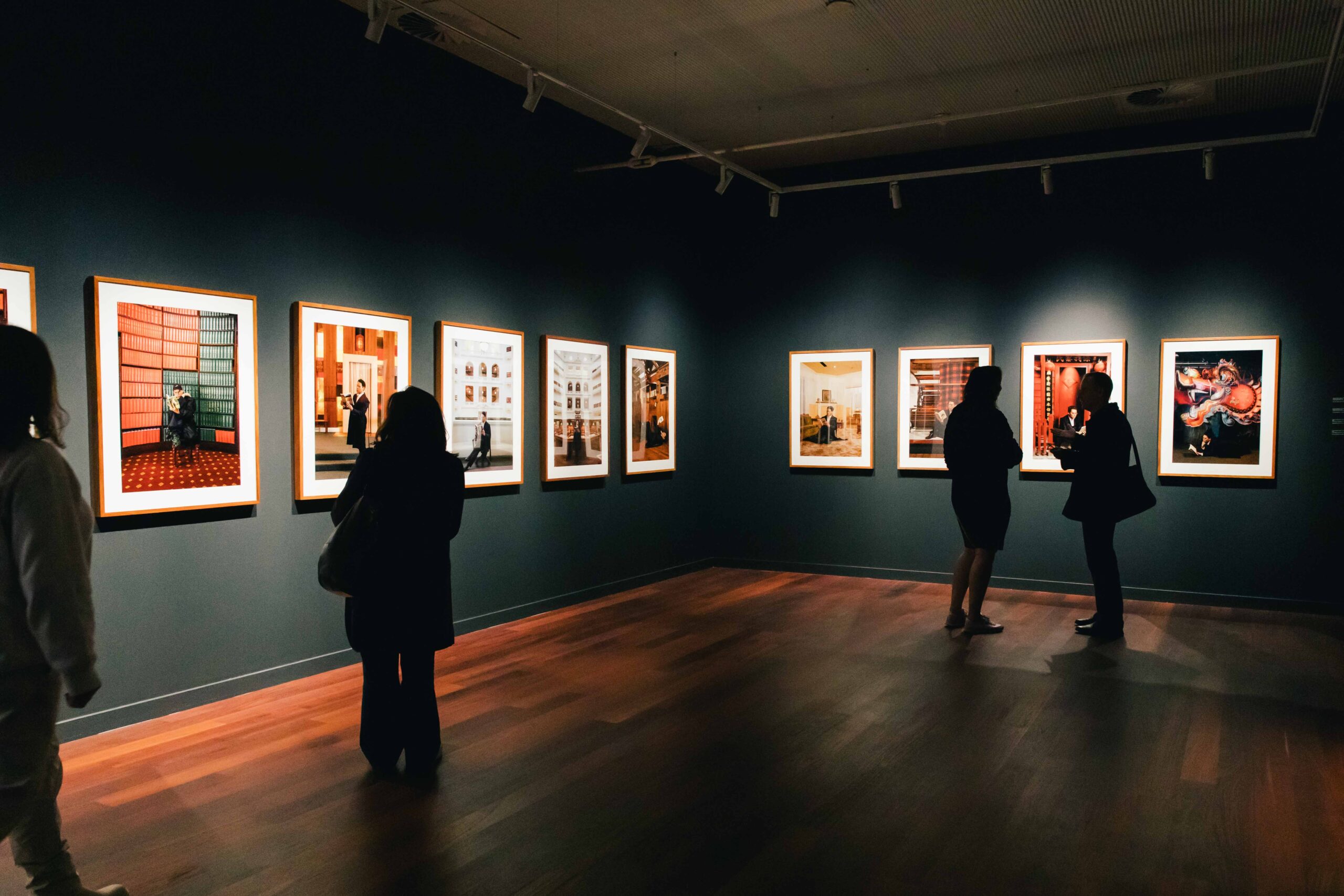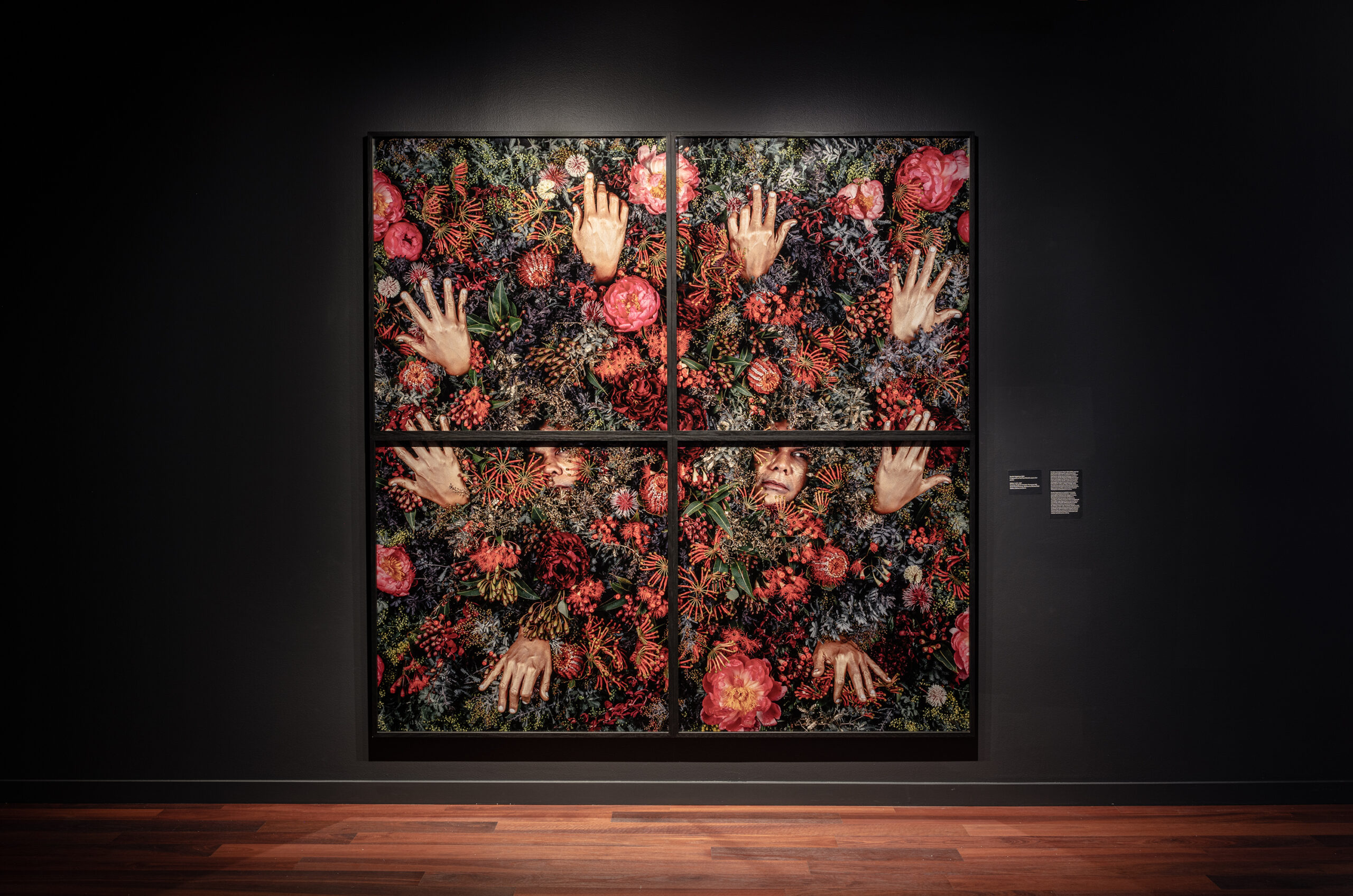Dr Christian Thompson AO | House of Gold
Dr Christian Thompson AO traverses and dissolves binary boundaries through an artistic practice which spans photography, performance, sculpture, moving image and sound. The artist critically engages with concepts of race, sexuality, gender and memory by inhabiting imagined personas, captured in fantastical environments frequently centred on native flora. With House of Gold, Thompson shifts focus to explore his Southern Chinese heritage, dating back to the 1850s Gold Rush migration boom.
Drawing inspiration from the Chinese proverb 书中自有黄金屋 [shū zhōng zì yǒu huáng jīn wū], or, a book in the hand holds a house of gold, this exhibition marks the debut presentation of Thompson’s complete series House of Gold for the first time. Photographed on location, these photographs see the artist populating colonial historical buildings, including the Parliament of Victoria, the State Library of Victoria, the National Wool Museum (the former Dennys Lascelles Ltd. woolstore, built 1872), the Chinese Museum (former Cohen Bros furniture warehouse, built 1890), and Golden Dragon Museum (located on the historic site of Bridge St Chinatown, Bendigo). Utilising the body as a symbol of resistance, Thompson’s mines sites of colonial history as an act of quiet rebellion to the structural exclusion of authority within this country and subverts the power dynamics such institutions hold.
Supporting this emerging body of work are selected inclusions from New Gold Mountain, a series honouring the contributions of Thompson’s Chinese-Australian lineage, in particular his grandmother Harriet and great uncles Frederick and Charles. Speaking to the importance of cultural connection, this series is a proud celebration dedicated to the resilience and perseverance his family experienced, from the Chinese Immigration Act 1855 to the negative social discrimination experienced daily.
House of Gold chronicles a personal history of intersectional identity at generational scale. Dr Christian Thompson AO gives us glimpses of intimate moments shared between both his Bidjara and Cantonese family – learnings of language, food and self that make the artist whole.
House of Gold is presented by 4A Centre for Contemporary Asian Art, in partnership with Golden Dragon Museum Bendigo, supported by The Robert H.N. Ho Family Foundation Global.
Visit House of Gold on the 4A website
Credits:
Thea-Mai Baumann (Co-curator)
Con Gerakaris (Co-curator)
Reina Takeuchi (Curatorial Assistant)

Dr Christian Thompson AO, House of Gold Chapter 12 (Golden Dragon Museum, Bendigo), cropped detail, 2024
About the Artist
Dr Christian Thompson AO is a Bidjara/Chinese-Australian contemporary artist whose work explores identity and history. Formally trained as a sculptor, Thompson’s practice spans photography, video, sculpture, performance and sound. Burdi Burdi (Fire Fire), 2021, is from Thompson’s series New Gold Mountain, which explores his first-generation southern-Chinese gold-rush heritage. Underpinned by his idea that to sing even one word of his Bidjara language means it cannot be described as extinct, Thompson uses the art context as a site to archive and present the practice of spoken language within the broader culture, occupying a rare and powerful space. Acquired by the NGV for Melbourne Now, the four-channel sound installation concerns the threat to, and loss of, First Nations languages. Visitors to the vibrant red room on the second level of the Ian Potter Centre: NGV Australia become immersed in the sounds of Thompson singing in his father’s native Bidjara language, now officially classified as severely endangered.
Underscoring his singing is a combination of synth-heavy instrumentation, breath and spoken word. As well as exploring Thompson’s experiences of the Bidjara language, Burdi Burdi (Fire Fire) is a tender, personal case for the revitalisation of First Nations languages, bringing forward 60,000 years of narrative and experiences embedded in the lilting textures and rhythms of Thompson’s voice and the language of what Thompson describes as ‘pre-invasion Australia’.
Thompson’s work has been exhibited all over the world across his more than two-decade career. In 2010 he made history as the first Aboriginal Australian to be admitted to Oxford University. A research affiliate at the Pitt Rivers Museum, Thompson holds a PhD (Fine Art) from Trinity College, University of Oxford, as well as degrees in theatre, sculpture and fine art. His work is held in major collections including the Museum of Contemporary Art and Art Gallery of NSW in Sydney; National Gallery of Australia, Canberra; National Gallery of Victoria; Queensland Art Gallery and the University of Queensland Art Museum, Brisbane; and the Aboriginal Art Museum, Utrecht. A major survey exhibition of Thompson’s work, Christian Thompson: Ritual Intimacy toured nationally between 2017 and 2019. In 2018 Thompson was made an Officer of the Order of Australia in the Queen’s Birthday Honours for his service to the visual arts.
Interview with Dr Christian Thompson AO
About the Project
4A Centre for Contemporary Asian Art undertook a research and development initiative in collaboration with Aboriginal Australian-Chinese artist Dr. Christian Thompson AO. Building upon the foundation of his prior artistic works, notably New Gold Mountain (2021), the House of Gold research and development project aimed to unravel the enduring legacy of the Chinese diaspora in Australia, tracing its origins from the era of the 1850s Gold Rush to its present-day manifestations.
Central to this research initiative is Dr. Thompson’s investigation into the experiences of the first generation of Chinese miners hailing from the Guangdong region who ventured to Australia during the Gold Rush period. Beyond merely documenting historical events, Dr. Thompson examined the intricate interplay between the Chinese migrants’ aspirations and the pervasive impact of the discriminatory White Australia Policy (1901 – 1973) on their lives. This exploration sheds light on the challenges, resilience, and cultural tenacity that characterised this community throughout a period marred by systemic racism.
The outcomes of House of Gold were then showcased at 4A (20 April – 2 June 2024), situated in a heritage-listed building in Chinatown amid rapid urban developments. This presentation connected strongly with preserving Chinatown’s heritage and the history of early Chinese migration. The work not only honours the struggles and contributions of the Chinese diaspora but also intersects with the crucial task of protecting Aboriginal identity from erasure. Chinatown and Indigenous cultures are interwoven into Australia’s national identity, sharing histories marred by injustices and suppression. Just as Aboriginal communities faced historical injustices, Chinese immigrants encountered discrimination and marginalisation. These efforts rejuvenate a cultural hub, highlighting the significance of embracing diversity for a united, harmonious future.

Dr Christian Thompson AO on location at 4A Centre for Contemporary Asian Art, photography by Kai Wasikowski
About the Tour
Museums & Galleries of NSW is partnering with 4A Centre for Contemporary Asian Art to tour House of Gold.
- The concepts and content of the exhibition are not only nationally significant by this well-respected artist, but also afford opportunities for venues to connect further with local First Nations and Chinese histories, arts and cultures.
- Offers educational opportunities for primary, secondary and tertiary students and teachers across visual arts, performance, visual literacy and social history.
- For the community, the exhibition makes links with libraries, research, botanical studies, family histories, and stories passed down through multiple generations.
- The exhibition will be accompanied by an installation guide and comprehensive educational resources.

Dr Christian Thompson AO, Double Happiness (2021), installation view, 4A Centre for Contemporary Art, photograph by Anna Hay
About Museums & Galleries of NSW
Museums & Galleries of NSW helps small-medium museums, galleries and Aboriginal cultural centres create exciting experiences for visitors and, through this, thriving local NSW communities.We don’t run museums, galleries and cultural centres but we care about those who do. We develop their skills, connect them with others in the industry, provide funding, point visitors their way, and give them access to ground-breaking exhibitions. M&G NSW offices are located on Gadigal Land, The Rocks, Sydney.
About 4A Centre for Contemporary Asia Art
4A Centre for Contemporary Asian Art champions the practices of Asian artists and elevates cross-cultural dialogues between Australia and Asia.
4A Centre for Contemporary Asian Art (4A) is an independent not-for-profit organisation based in Sydney, Australia. Since 1996, 4A has fostered excellence and innovation in contemporary culture through the commissioning, presentation, documentation and research of contemporary art. Our program is presented throughout Australia and Asia, where we ensure that contemporary art plays a central role in understanding and developing the dynamic relationship between Australia and the wider Asian region.
4A’s activities facilitate cultural dialogue between Australia and Asia in the belief that Asian cultural thinking significantly shapes the world today and will have an important impact on the future. In Australia, we showcase stories, present a multiplicity of perspectives, and explore contemporary concerns and ideas that influence how we, as a nation, engage with Asia. We have a particular focus on art that addresses Asian-Australian experiences and the contributions that diverse Asian migration has made ⎯ and continues to make ⎯ in shaping Australia. 4A’s focus in Asia is to promote the breadth of Australian artistic talent, seeking to build an image of Australia that is open, progressive and fundamentally connected with our Asian neighbours.
4A has been a leader in Asian contemporary art in Australia since 1996; in the decades since, we have established a highly respected reputation among artists and audiences and within an expanding network of international art institution peers. Our long history and ongoing work across Asia is recognised as having raised awareness of Asian-Australian art and culture. We continue to celebrate Australia’s diverse cultural heritage and growing links throughout the wider Asian region.
Itinerary
Wagga Wagga Art Gallery, NSW
3 November 2025 – 26 January 2026
Manning Regional Art Gallery, NSW
6 February – 28 March 2026
Cairns Art Gallery, QLD
11 April – 14 June 2026
Grafton Regional Gallery, NSW
4 July – 6 September 2026
Jervis Bay Maritime Museum & Gallery, NSW
24 September – 10 November 2026
Orange Regional Gallery, NSW
28 November 2026 – 7 February 2027
Qantas Founders Museum, Longreach, QLD
February – May 2027
Toowoomba Regional Art Gallery, QLD
17 May – 4 September 2027
Art Gallery of Ballarat, VIC
2 October – 11 December 2027
Bunjil Place, VIC
19 December 2027 – 28 February 2028
Plimsoll Gallery | University of Tasmania, TAS
11 March – 30 April 2028
A 4A Centre for Contemporary Asian Art exhibition, in partnership with Golden Dragon Museum Bendigo, supported by The Robert H.N. Ho Family Foundation Global and touring with Museums & Galleries of NSW. This project has been assisted by the Australian Government’s Visions of Australia program.









